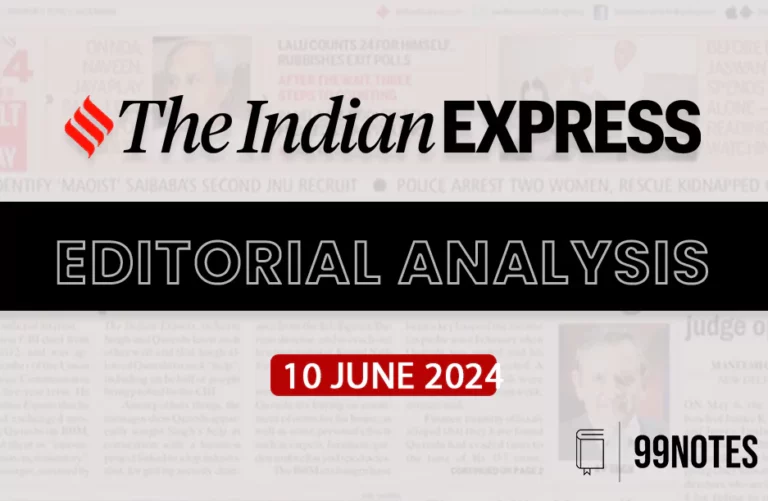22 September 2023 : Indian Express
Indian Express
22-September-2023
The Indian Express, CSE candidates can stay informed about current events and developments in India and around the world.
1) Expansion of BRICS-How it matters?
Context:
- The recent BRICS summit in Johannesburg, South Africa, which witnessed more than a doubling of its original membership of five major emerging economies, has led to exaggerated expectations of the grouping’s rising influence on the global economy and on the restructuring of global governance regimes.
- This article will discuss the various reasons due to which many countries want to join BRICS and also the impact it would have on India.
Background
- The predecessor of BRICS (Brazil, Russia, India, China, and South Africa) was BRIC (Brazil, Russia, India, and China) established by Goldman Sachs in 2006.
- BRIC was the acronym for the four countries, which were deemed to be at a similar stage of newly advanced economic development.
- Behind BRIC was the idea that China and India will, by 2050, be the world’s dominant suppliers of manufactured goods, while Brazil and Russia will become dominant as suppliers of raw materials.
- With the induction of South Africa in December 2010, BRIC became BRICS whose original aim was the establishment of an equitable, democratic and multi-polar world order.
- The BRICS mechanism aims to promote peace, security, development and cooperation.
- It also aims at contributing significantly to the development of humanity and establishing a more equitable and fairer world.
BRICS EXPANSION
- The BRICS brings together five of the largest developing countries in the world—Brazil, Russia, India, China, and South Africa and represents 41 percent of the global population, 24 percent of the global GDP and 16 percent of the global trade.
- Several countries, including Argentina, Egypt, Indonesia, the UAE, Saudi Arabia, and others, are willing to join the bloc.
The proposition
- BRICS is considering expanding its membership, and a growing number of countries, mostly from the global South, have expressed interest in joining.
- Several countries including the United Arab Emirates, Saudi Arabia, Argentina, Iran, Egypt, Bahrain, Indonesia, and Kazakhstan have shown their willingness to join the BRICS.
- As per reports, more than 40 nations have indicated an interest in joining the bloc of major developing economies.
- Earlier in June, representatives from Iran, Saudi Arabia, the United Arab Emirates, Cuba, the Democratic Republic of Congo, Comoros, Gabon, and Kazakhstan attended a meeting in Cape Town for so-called “Friends of BRICS” talks. Egypt, Argentina, Bangladesh, Guinea-Bissau, and Indonesia participated virtually.
The Need for Expansion
- Many countries of the Global South are showing such an unusual interest in BRICS because of their desire to hedge in an increasingly uncertain world with shifting political and security equations.
- An expansion of the BRICS bloc is under consideration since potential candidates – from Iran to Argentina – see one thing in common: a desire to level a global playing field.
- This is lacking because of the wealthy West’s domination of international bodies, such as the United Nations, the International Monetary Fund or the World Bank.
- The list of grievances is long:
- Abusive trade practices.
- Punishing sanctions regimes.
- Perceived neglect of the development needs of poorer nations.
- Amid widespread dissatisfaction with the prevailing world order, the pledge of BRICS nations – currently Brazil, Russia, India, China and South Africa – to make the grouping a leading champion of the “Global South”has, found resonance.
Benefits of the BRICS Expansion plan
- Here are some of the benefits of the BRICS Expansion plan and launching of BRICS currency:
Increased Economic Cooperation:
- The BRICS countries are working together to increase their economic cooperation.
- This could lead to increased trade, investment, and development.
Reduced reliance on the US dollar:
- The BRICS countries are trying to reduce their reliance on the US dollar.
- This could give them more control over their own economies and reduce their vulnerability to US economic policies.
Increased influence in the Global Economy:
- The BRICS countries are working to increase their influence in the global economy. This could lead to increased trade, investment, and development for these countries.
- When we look at the broader aspect the BRICS Expansion plan and launching of a common currency are ambitious projects. However, they could have a significant impact on the global economy.
- If successful, these projects could lead to increased economic cooperation, reduced reliance on the US dollar, and increased influence for the BRICS countries in the global economy.
Benefits specific to India
Here are some ways in which India could benefit from the expansion of BRICS and the launch of a new BRICS currency:
Reduced dependence on the US dollar:
- India is currently heavily dependent on the US dollar for its foreign trade and currency reserves.
- This makes India vulnerable to fluctuations in the value of the dollar, which can have a negative impact on India’s economy.
- A BRICS currency would provide India with an alternative to the dollar, which would reduce its dependence on the US and make its economy more stable.
Increased trade and investment:
- A BRICS currency would make it easier for India to trade with other BRICS countries.
- This could lead to increased trade and investment between India and other BRICS countries, which would boost India’s economy.
Reduced political pressure from the US
- The US has a history of using its financial power to exert political pressure on other countries.
- For example, the US has imposed sanctions on countries that do not cooperate with its sanctions on Iran.
- A BRICS currency would reduce India’s vulnerability to this type of political pressure from the US.
- Overall, the expansion of BRICS and the launch of a new BRICS currency could have a number of positive benefits for India. These benefits include reduced dependence on the US dollar, increased trade and investment, and reduced political pressure from the US.
Way Forward:
- For India, a policy of participating in multiple groupings, which helps address its now multi-faceted interests and aspirations, has proved to be a sound one.
- An expanded BRICS would expand India’s diplomatic options and help in smoothing the rough edges of an increasingly polarized world.
2) Need for India to scale up its Ethanol production
Context:
- With international oil prices nearing $100 per barrel once again, India’s import dependence on crude oil and products stood at an all-time high of 87.3 percent in FY2023, and 25.8 percent of the country’s import bill was spent on it.
- At the same time, estimates from the International Energy Agency suggested that in the last decade, upto 20 percent of our total primary energy supply was met by biomass, and a large portion of it was used by households.
- This article will discuss how ethanol blending programme could be helpful in reducing our dependency on imported crude oil.
About Ethanol Blended Programme:
- As part of its carbon reduction commitments, India had launched the Ethanol Blended Petrol (EBP) programme to mix this biofuel with petrol to reduce the consumption of fossil fuel.
- Launch: It was launched in January, 2003 in in 9 States and 4 UTs. Later, it was extended to whole of India except Union Territories of Andaman Nicobar and Lakshadweep islands with effect from 01st April, 2019.
- Objective: It seeks to achieve blending of Ethanol with motor sprit with a view to reducing pollution, conserve foreign exchange and increase value addition in the sugar industry enabling them to clear cane price arrears of farmers.
- Targets: In December 2020, the government advanced its target of achieving 20% blending (E20) from 2030 to 2025.
- In 2022, after a concerted policy push for five years, India’s blending programme achieved the significant milestone of 10 per cent ethanol blending in petrol.
What is Ethanol Blending?
- Ethanol blending refers to the practice of mixing a certain percentage of ethanol with conventional gasoline or petrol to create blended fuels.
- It is an effective way to reduce greenhouse gas emissions, improve air quality, and promote renewable energy usage in the transportation sector.
How it is done?
- Ethanol blending is achieved by mixing ethanol with gasoline in specific proportions.
- The most common blend is E10, which contains 10% ethanol and 90% gasoline.
- Blends like E15 (15% ethanol), E85 (85% ethanol), etc., are also used in certain regions depending on the suitability of vehicle engines.
What all steps need to be taken in order to attain the target set for 2025?
- Investments,
- The ability to provide (and divert) the necessary feedstock for the domestic production of ethanol.
- Biofuels
- Flex-fuel vehicles (that can run almost entirely on biofuels)
- Given the predominance of first-generation production, the often-discussed food energy-water nexus considerations must be put into practice at the earliest
- Electronic vehicles (EVs)
- India needs a robust assessment of these tradeoffs, and a clear research and development plan for 2G technologies, before it can scale up ethanol production.
Different Generations of Biofuels:
First Generation Biofuels
- Derived from food crops, such as sugarcane, corn, soybeans, and vegetable oils.
- Widely used and easily available, but criticized for potential competition with food production.
- Examples: Biodiesel, bioethanol, and vegetable oil-based fuels.
Second Generation Biofuels
- Produced from non-food feedstocks like agricultural residues, woody biomass, and waste materials.
- Address concerns about food competition and offer more sustainable options.
- Examples: Cellulosic ethanol, biobutanol, and biofuels from algae.
Third Generation Biofuels
- Focus on using microorganisms and algae to convert sunlight into biofuels through photosynthesis.
- Highly efficient in terms of land use and resource utilization.
- Examples: Algal biofuels and cyanobacterial biofuels.
Fourth Generation Biofuels
- Utilize advanced technologies to engineer microorganisms for biofuel production.
- Aim for higher yields and cost-effectiveness compared to previous generations.
- Examples: Synthetic biology-based biofuels and genetically engineered biofuels.
India’s Scenario:
- Much of India’s supply of ethanol for the blending programme comes from first-generation production using underlying sugars in food crops, mostly sugarcane (84 per cent) and grain (16 per cent).
- While the prospects for second-generation (2G) technologies for ethanol production are immense, investments have been slow and even Indian Oil’s state-of-the-art facility will only produce 3 crore litres of 2G ethanol.
- There are 12 such facilities in various stages of planning and construction but are unlikely to contribute to the lion’s share of ethanol demand.
Benefits of India’s ethanol blending mandates include:
- Reduce Import Dependency: Will save Foreign Exchange (FOREX).
- Cleaner Environment: Reducing crop burning and converting agricultural residues/wastes to biofuels will further reduce greenhouse gas (GHG) emissions.
- Health Benefits: Prolonged reuse of cooking oil for preparing food, particularly in deep-frying, is a potential health hazard and can lead to many diseases. Used cooking oil (UCO) is a potential feedstock for biodiesel and its use for making biodiesel prevents reuse of UCO within the food industry.
- Solid Waste Management: There are technologies available, which can convert solid waste and plastics to drop-in fuels.
- Infrastructural Investment in Rural Areas: Establishing additional 2G biorefineries across the country will spur infrastructural investment in rural areas.
- Employment Generation: 2G biorefinery can contribute 1200 jobs across plant operations, village level entrepreneurs and supply chain management.
- Additional Income to Farmers: By adopting 2G technologies, agricultural residues/wastes that otherwise are burnt can be converted to ethanol. Farmers can realise an additional revenue source if markets are developed for these residues/wastes.
Way Forward:
- At a time when the automobile industry is grappling with the challenges of transitioning to EVs, a well-thought-out and implementable plan to transform the way India moves, will not only help reduce the import bill but also buy us time to help transition a marquee industry of our economy.
- It will not only ensure a sustainable reduction in GHG emissions but also provide multiple economic and environmental co-benefits.
- A long-term, sustainable approach to ethanol production can help India become a champion for sustainable transport biofuels.
For Enquiry

22 September 2023 : Indian Express

22 September 2023 : PIB

22 September 2023 : Daily Current Affair

22 September 2023 : The Hindu Editorial Notes PDF

21 September 2023 : Daily Quiz

21 September 2023 : Daily Answer Writing

21 September 2023 : Indian Express

21 September 2023 : PIB

21 September 2023 : Daily Current Affair

21 September 2023 : The Hindu Editorial Notes PDF
Indian Express 22 September 2023 : Indian Express Indian Express
21-September-2023
The Indian Express, CSE candidates can stay informed about current events…
PIB 22 September 2023 : PIB PRESS INFORMATION BUREAU
22-September -2023
Daily Current Affairs For UPSC ,The PIB ( Press Information…
Daily Current Affairs 22 September 2023 : Daily Current Affair Daily Current Affairs
22-September-2023
Daily Current Affairs For UPSC ,Daily Current affairs of The…
September- The Hindu Editorial 22 September 2023 : The Hindu Editorial Notes PDF The Hindu Editorial
22-September-2023
Daily Current Affairs For UPSC ,The Hindu Editorial Summary
Facebook-f
Twitter
Youtube
1. Propelling…
Daily Quiz 21 September 2023 : Daily Quiz 21 Sep 2023 : Daily Quiz…
mains answer writing 21 September 2023 : Daily Answer Writing Mains Answer Writing
One of the key components of these exams is the written test, which consists of…
Indian Express 21 September 2023 : Indian Express Indian Express
21-September-2023
The Indian Express, CSE candidates can stay informed about current…
PIB 21 September 2023 : PIB PRESS INFORMATION BUREAU
21-September -2023
Daily Current Affairs For UPSC ,The PIB ( Press Information…
Daily Current Affairs 21 September 2023 : Daily Current Affair Daily Current Affairs
21-September-2023
Daily Current Affairs For UPSC ,Daily Current affairs of The…
September- The Hindu Editorial 21 September 2023 : The Hindu Editorial Notes PDF The Hindu Editorial
21-September-2023
Daily Current Affairs For UPSC ,The Hindu Editorial Summary
Facebook-f
Twitter
Youtube
1. Taking…




